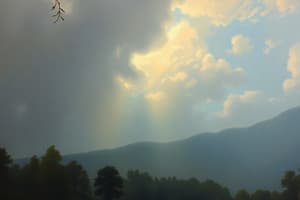Podcast
Questions and Answers
How would you describe permanent winds such as trade winds and westerlies?
How would you describe permanent winds such as trade winds and westerlies?
- Winds influenced by mountainous terrain, causing unpredictable patterns.
- Winds that reverse direction based on specific weather events.
- Winds that maintain a consistent direction annually. (correct)
- Winds that change direction daily due to temperature variations.
What effect would an increase in greenhouse gases have on weather patterns?
What effect would an increase in greenhouse gases have on weather patterns?
- Stabilized temperatures worldwide and more predictable weather events.
- Decreased average global temperatures and reduced precipitation.
- Increased average global temperatures and altered precipitation patterns. (correct)
- Localized cooling in tropical areas and decreased frequency of storms.
Which of the following best describes why the amount of insolation decreases from the equator toward the poles?
Which of the following best describes why the amount of insolation decreases from the equator toward the poles?
- Atmospheric pollution is denser near the poles, blocking more sunlight.
- The Earth's tilt causes sunlight to strike the poles at a more oblique angle, spreading the energy over a larger area. (correct)
- The ozone layer is thinner at the poles, absorbing less solar energy.
- Landmasses at the poles absorb more sunlight than the oceans near the equator.
If a location is experiencing high air pressure, which weather conditions are most likely?
If a location is experiencing high air pressure, which weather conditions are most likely?
Which of the following is the most accurate description of local winds?
Which of the following is the most accurate description of local winds?
How does the presence of the ozone layer that exists in the atmosphere benefit life on Earth?
How does the presence of the ozone layer that exists in the atmosphere benefit life on Earth?
Which of the following statements describes what happens to air pressure as you move upwards through the layers of the atmosphere, and why?
Which of the following statements describes what happens to air pressure as you move upwards through the layers of the atmosphere, and why?
If a humid day prevents wet clothes from drying quickly, what is the primary reason?
If a humid day prevents wet clothes from drying quickly, what is the primary reason?
Flashcards
Atmosphere
Atmosphere
The layer of gases surrounding the Earth.
Major Gases in Atmosphere
Major Gases in Atmosphere
Nitrogen and oxygen make up the bulk of the atmosphere.
Greenhouse Gas
Greenhouse Gas
Gases like carbon dioxide that trap heat in the atmosphere.
Types of Winds
Types of Winds
Signup and view all the flashcards
Permanent Winds
Permanent Winds
Signup and view all the flashcards
Seasonal Winds
Seasonal Winds
Signup and view all the flashcards
Local Winds
Local Winds
Signup and view all the flashcards
Air Pressure
Air Pressure
Signup and view all the flashcards
Study Notes
Air Composition
- The atmosphere is a mixture of gases, mostly nitrogen (78%) and oxygen (21%).
- Other gases include argon (0.93%), carbon dioxide (0.03%), and trace amounts of others.
- Tiny dust particles are also present in the air.
Greenhouse Effect
- Carbon dioxide in the atmosphere traps heat radiated from the Earth.
- This is called the greenhouse effect, and without it, Earth would be too cold to support life.
- Increased levels of carbon dioxide, from sources like smoke and car fumes, cause global warming.
Global Warming
- Global warming is an increase in the Earth's temperature caused by increased levels of greenhouse gases, in particular, carbon dioxide in the atmosphere.
- This leads to melting snow and ice, causing sea levels to rise and floods in coastal areas.
- Global warming can lead to extinction of some plants and animals.
Layers of the Atmosphere
- The atmosphere is divided into five layers: troposphere, stratosphere, mesosphere, thermosphere, and exosphere.
- The troposphere is the lowest layer, where weather occurs, and its height is approximately 13 km.
- The stratosphere contains the ozone layer, protecting us from harmful UV radiation.
- The other layers become progressively thinner with increasing altitude.
Weather
- Weather refers to the short-term state of the atmosphere, such as temperature, humidity, precipitation, cloud cover, and wind.
- Climate refers to the typical weather conditions in a place over a long period of time.
- Temperature is a measure of the hotness or coldness of the air.
- Insolation is the incoming solar energy intercepted by the Earth.
- The amount of insolation decreases towards the poles.
Air Pressure
- Air pressure is the force exerted by the weight of the air on the Earth's surface.
- Air pressure decreases with increasing altitude.
- High-pressure areas are associated with clear, sunny skies, and low-pressure areas are associated with cloudy, wet weather.
Winds
- Wind is the horizontal movement of air from high-pressure areas to low-pressure areas.
- Winds are named after the direction from which they blow.
- Types include trade winds, westerlies, easterlies, and seasonal winds like monsoons.
Rainfall Types
- Rainfall is important for plant and animal survival, but too much can cause flooding.
- Types of rainfall include convective, orographic, and cyclonic.
Studying That Suits You
Use AI to generate personalized quizzes and flashcards to suit your learning preferences.




